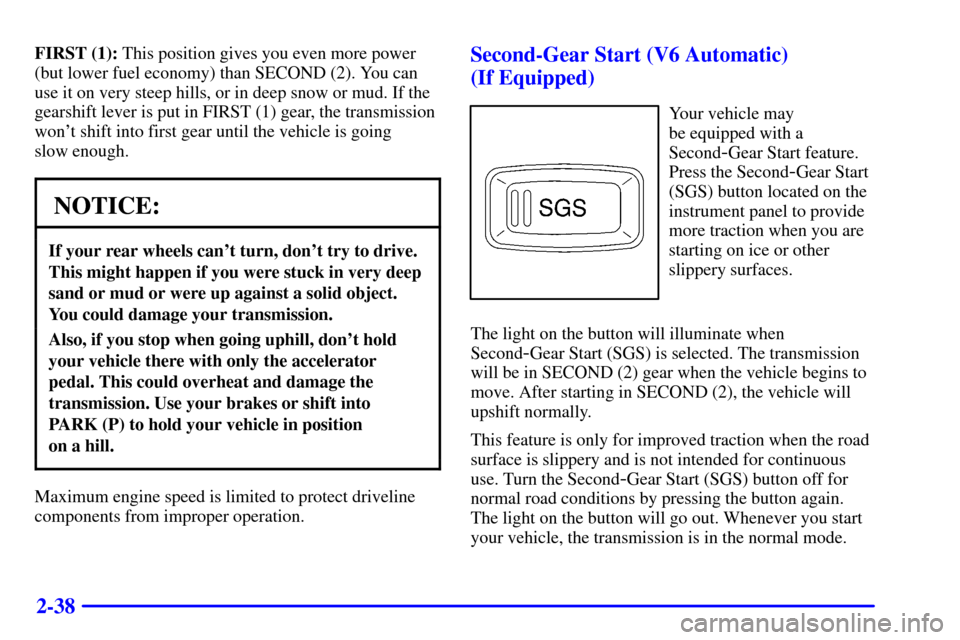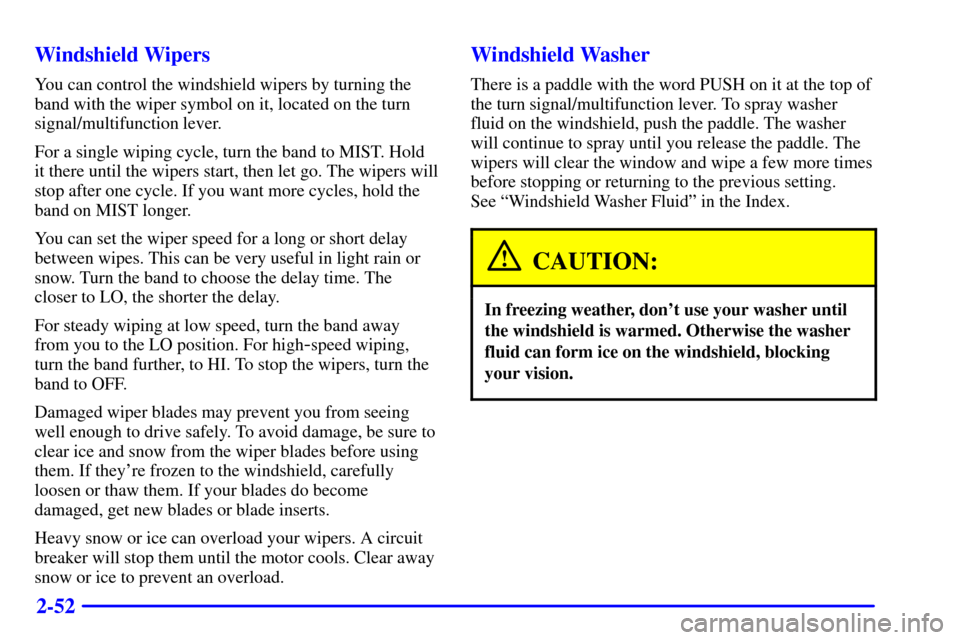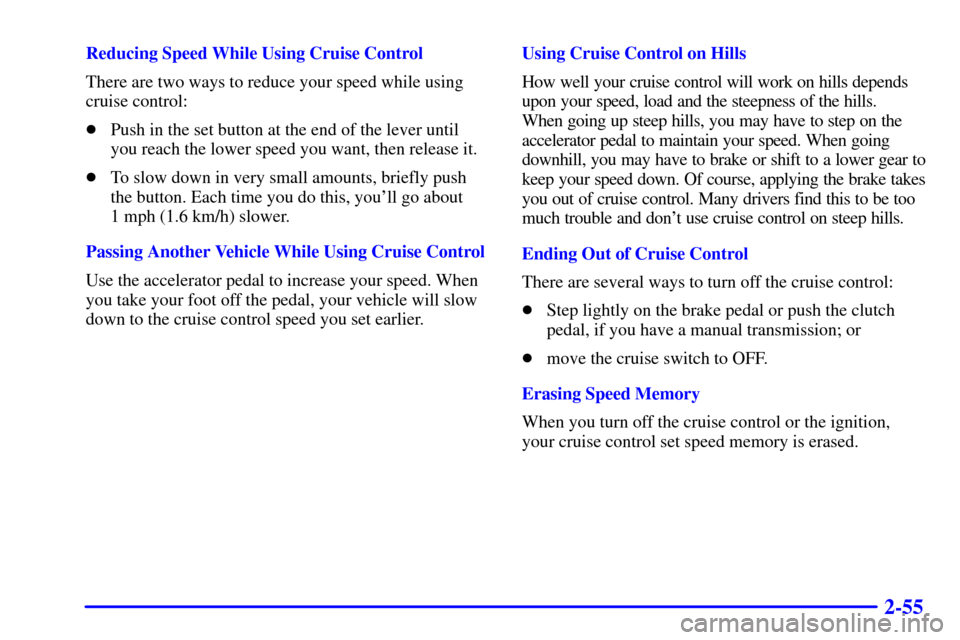Page 96 of 363

2-38
FIRST (1): This position gives you even more power
(but lower fuel economy) than SECOND (2). You can
use it on very steep hills, or in deep snow or mud. If the
gearshift lever is put in FIRST (1) gear, the transmission
won't shift into first gear until the vehicle is going
slow enough.
NOTICE:
If your rear wheels can't turn, don't try to drive.
This might happen if you were stuck in very deep
sand or mud or were up against a solid object.
You could damage your transmission.
Also, if you stop when going uphill, don't hold
your vehicle there with only the accelerator
pedal. This could overheat and damage the
transmission. Use your brakes or shift into
PARK (P) to hold your vehicle in position
on a hill.
Maximum engine speed is limited to protect driveline
components from improper operation.
Second-Gear Start (V6 Automatic)
(If Equipped)
Your vehicle may
be equipped with a
Second
-Gear Start feature.
Press the Second
-Gear Start
(SGS) button located on the
instrument panel to provide
more traction when you are
starting on ice or other
slippery surfaces.
The light on the button will illuminate when
Second
-Gear Start (SGS) is selected. The transmission
will be in SECOND (2) gear when the vehicle begins to
move. After starting in SECOND (2), the vehicle will
upshift normally.
This feature is only for improved traction when the road
surface is slippery and is not intended for continuous
use. Turn the Second
-Gear Start (SGS) button off for
normal road conditions by pressing the button again.
The light on the button will go out. Whenever you start
your vehicle, the transmission is in the normal mode.
Page 99 of 363
2-41 Shift Speeds
CAUTION:
If you skip a gear when you downshift, you could
lose control of your vehicle. You could injure
yourself or others. Don't shift down more than
one gear at a time when you downshift.
This chart shows when to shift to the next higher gear
for best fuel economy.If your speed drops below 20 mph (32 km/h), or if the
engine is not running smoothly, you should downshift to
the next lower gear. You may have to downshift two or
more gears to keep the engine running smoothly or for
good performance.
NOTICE:
If you skip more than one gear when you
downshift, or if you race the engine when you
downshift, you can damage the clutch
or transmission.
Skip Shift Light (5.7L V8 Engine)
When the SKIP SHIFT light
is on, the gearshift lever
will let you shift from
FIRST (1) to FOURTH (4)
instead of shifting from
FIRST (1) to SECOND (2).
Once you are in FOURTH (4), you can press the clutch
again and shift into another gear.
Page 100 of 363
2-42
This feature helps you to get the best possible fuel economy.
It will come on under these conditions:
�The engine coolant temperature is greater
than 170�F (77�C),
�You are going 15 to 20 mph (24 to 32 km/h) and
�You are at 35 percent throttle or less.
Follow the shift speeds listed below when the
SKIP SHIFT light is on.
Computer
-Aided Manual Transmission Shift Speeds
�1st to 4th @ 15 mph (24 km/h)
�4th to 5th @ 25 mph (40 km/h)*
�5th to 6th @ 49 mph (64 km/h)**
Each time you come to a stop, the engine's Powertrain
Control Module (PCM) determines when to activate the
skip shift upshift system. The skip shift upshift system is
bypassed when you accelerate very quickly from a stop.
*30 mph (48 km/h) when accelerating to highway speeds.
**45 mph (72 km/h) when accelerating to highway speeds.
Parking Brake
To set the parking brake, hold the brake pedal down and
pull up on the parking brake lever. If the ignition is on,
the brake system warning light will come on.
Page 109 of 363

2-51 Turn Signal and Lane Change Indicator
The turn signal has two upward (for right) and two
downward (for left) positions. These positions allow you
to signal a turn or a lane change.
To signal a turn, move the lever all the way up or down.
When the turn is finished, the lever will return automatically.
An arrow on the instrument
panel cluster will flash in
the direction of the turn or
lane change.
To signal a lane change, just raise or lower the lever
until the arrow starts to flash. Hold it there until you
complete your lane change. The lever will return by
itself when you release it.As you signal a turn or a lane change, if the arrows don't
flash but just stay on as you signal a turn or lane change,
a signal bulb may be burned out and other drivers won't
see your turn signal.
If a bulb is burned out, replace it to help avoid an
accident. If the arrows don't go on at all when you
signal a turn, check the fuse (see ªFuses and Circuit
Breakersº in the Index).
Headlamp High/Low-Beam Changer
When the high beams are
on, this light located on the
instrument panel cluster
also will be on.
To change the headlamps from low beam to high or high
beam to low, pull the turn signal lever all the way
toward you. Then release it.
Page 110 of 363

2-52 Windshield Wipers
You can control the windshield wipers by turning the
band with the wiper symbol on it, located on the turn
signal/multifunction lever.
For a single wiping cycle, turn the band to MIST. Hold
it there until the wipers start, then let go. The wipers will
stop after one cycle. If you want more cycles, hold the
band on MIST longer.
You can set the wiper speed for a long or short delay
between wipes. This can be very useful in light rain or
snow. Turn the band to choose the delay time. The
closer to LO, the shorter the delay.
For steady wiping at low speed, turn the band away
from you to the LO position. For high
-speed wiping,
turn the band further, to HI. To stop the wipers, turn the
band to OFF.
Damaged wiper blades may prevent you from seeing
well enough to drive safely. To avoid damage, be sure to
clear ice and snow from the wiper blades before using
them. If they're frozen to the windshield, carefully
loosen or thaw them. If your blades do become
damaged, get new blades or blade inserts.
Heavy snow or ice can overload your wipers. A circuit
breaker will stop them until the motor cools. Clear away
snow or ice to prevent an overload.
Windshield Washer
There is a paddle with the word PUSH on it at the top of
the turn signal/multifunction lever. To spray washer
fluid on the windshield, push the paddle. The washer
will continue to spray until you release the paddle. The
wipers will clear the window and wipe a few more times
before stopping or returning to the previous setting.
See ªWindshield Washer Fluidº in the Index.
CAUTION:
In freezing weather, don't use your washer until
the windshield is warmed. Otherwise the washer
fluid can form ice on the windshield, blocking
your vision.
Page 113 of 363

2-55
Reducing Speed While Using Cruise Control
There are two ways to reduce your speed while using
cruise control:
�Push in the set button at the end of the lever until
you reach the lower speed you want, then release it.
�To slow down in very small amounts, briefly push
the button. Each time you do this, you'll go about
1 mph (1.6 km/h) slower.
Passing Another Vehicle While Using Cruise Control
Use the accelerator pedal to increase your speed. When
you take your foot off the pedal, your vehicle will slow
down to the cruise control speed you set earlier.Using Cruise Control on Hills
How well your cruise control will work on hills depends
upon your speed, load and the steepness of the hills.
When going up steep hills, you may have to step on the
accelerator pedal to maintain your speed. When going
downhill, you may have to brake or shift to a lower gear to
keep your speed down. Of course, applying the brake takes
you out of cruise control. Many drivers find this to be too
much trouble and don't use cruise control on steep hills.
Ending Out of Cruise Control
There are several ways to turn off the cruise control:
�Step lightly on the brake pedal or push the clutch
pedal, if you have a manual transmission; or
�move the cruise switch to OFF.
Erasing Speed Memory
When you turn off the cruise control or the ignition,
your cruise control set speed memory is erased.
Page 114 of 363

2-56
Exterior Lamps
The main lamp control operates the following lamps:
�Headlamps
�Taillamps
�Parking Lamps
�License Lamps
�Sidemarker Lamps
�Instrument Panel Lights
Turn the knob to this position to turn on your
parking lamps and other operating lamps without
your headlamps.
Turn the knob to this position to turn on your
headlamps and other operating lamps.
Turn the knob to this position to turn off all
the lamps.
Headlamps on Reminder
If you turn the ignition to OFF and leave the lamps on,
you will hear a chime, lasting up to five seconds. If the
lamps are still on when you open the driver's door, the
chime will sound again.
Daytime Running Lamps / Automatic
Headlamp Control (If Equipped)
Daytime Running Lamps (DRL) can make it easier for
others to see the front of your vehicle during the day.
DRL can be helpful in many different driving
conditions, but they can be especially helpful in the
short periods after dawn and before sunset. Fully
functional daytime running lights are required on all
vehicles first sold in Canada.
Page 115 of 363

2-57
A light sensor on top of the instrument panel automatically
turns the headlamps on, so be sure it isn't covered.
The DRL will not activate if the parking brake is
engaged prior to turning the ignition on.
The DRL system will make your front turn signal lamps
come on when:
�The ignition is on,
�the headlamp switch is off,
�the parking brake is released, and
�it is bright enough outside.
When the DRL are on, only your front turn signal lamps
will be on. The taillamps, sidemarker and other lamps
won't be on. Your instrument panel won't be lit up
either. When you use your turn signals, the front turn
signal and the taillamp on the desired side will flash.
When it's dark enough outside, your front turn signal
lamps will go out and your headlamps will come on.
The other lamps will also come on.
When it's bright enough outside, the regular lamps will
go off, and your front turn signal lamps will come on.
As with any vehicle, you should turn on the regular
headlamp system when you need it.Fog Lamps (Option)
Use your fog lamps for better vision in foggy or misty
conditions. Your parking lamps must be on or your fog
lamps won't work.
Your fog lamp button is
located on your console,
above the audio system.
To turn the fog lamps on, push the right side of the fog
lamp switch and a light on the switch will come on
indicating that the fog lamps are on. Push the left side
of the switch to turn the fog lamps off.
The fog lamps will go off whenever your high
-beam
headlamps come on. When the high
-beam headlamps
go off, the fog lamps will come on again.